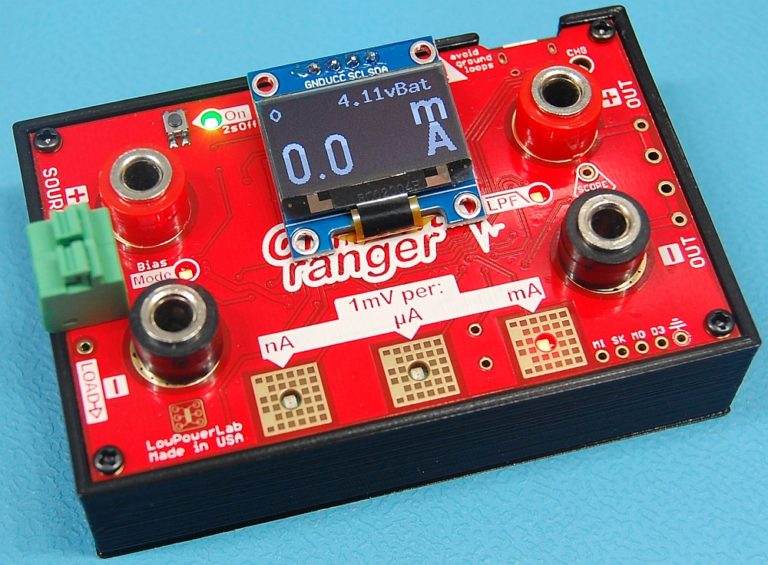UPDATE: although I still like the uCurrent and CurrentRanger, there’s a new king of the hill for current measurement here: the JouleScope. I’ll leave this post up because the uCurrent and CurrentRanger are much less expensive than JouleScope, but if you want best-in-class current measurement for IoT devices, JouleScope is clearly the way to go; I’ll post a detailed review soon.
I’ve long relied on the uCurrent Gold to measure low currents (micro-amps, nano-amps) in the IoT devices I design, but it is no longer in production. So I recently purchased a CurrentRanger from Low Power Labs which offers the same ultra-low burden voltage measurement and adds several enhancements.

Both devices use very low value current sense resistors to impose minimum burden voltage and use low noise, low offset gain stages to amplify the current into a proportional voltage that is presented on the output terminals and that you can measure with a multimeter. So, for example, if operating in the uA range, a 33uA current through the supply->load terminals will result in a 33mV output on the output terminals.
The CurrentRanger is improved over the uCurrent in several ways including:
- Fast auto-ranging using an internal microcontroller allowing use of the device to monitor battery powered IoT devices which typically exhibit a very wide dynamic range of current consumption (often from nA or a few uA in sleep mode to hundreds of mA when transmitting).
- An optional OLED display which provides a convenient way to monitor the current without having to connect a multimeter to the output terminals. (albeit limited by the ucontroller’s ADC input granularity and accuracy). This can save a lot of wiring clutter and bench space.
- Powered by an internal rechargeable lithium polymer battery (that you must supply) which it can charge from the built-in micro-USB connector. This is handier than the coin cells that the uCurrent uses which tend to run out at inconvenient times and replacements aren’t always at hand. It can also be used with 3x AA batteries (you’ll need to supply the battery holder), but if so you must not have the batteries installed while the USB cable is connected (the USB connection powers the internal lithium battery charger which would damage AA cells).
- Supports/suggests external data logging using a TTL serial interface or an optional HC-06 bluetooth module for electrically isolated data logging which also helps prevent cluttering your bench with more wires. The HC-06 is a class 2 bluetooth slave module that does transparent serial communications bridging. I’ll write another post regarding the HC-06 module, but you can see its datasheet here and buy them on amazon or AliExpress or eBay or a host of other sites (they are popular); there are also less expensive DX-BT18 modules (manual here) that claim to be compatible and supports BT4.2 including support for SPP and BLE. At least some versions are actually FCC certified (2ADMF-HC06 and 2AKS8DX-BT18)…I checked the FCC – which you should always do. There are many clones and compatible modules such as the JDY-08 (also here) and JDY-40 available for under $1 that are not FCC certified.
I tested the Current Ranger uA range with several precision resistors (100K, 470K, 1M) as fixed loads. The voltage output was spot on and the burden voltage was negligible. Compared with my much more expensive Advantest R6552 AC-powered bench meter, the Current Ranger offered slightly lower (better) burden voltage and slightly better accuracy. The only issue I noticed was that while the voltage output was spot-on, the OLED display read about 1uA too low across the uA range (i.e. it had a fixed offset, not a percentage error). This isn’t a big deal for me, but it’s worth noting. Overall I am quite pleased with the Current Ranger. The precision was excellent, it is well designed, very compact, and allows taking and logging current measurements across a wide dynamic consumption range, ideal for IoT devices.
